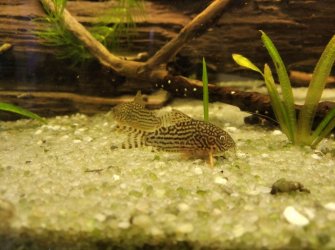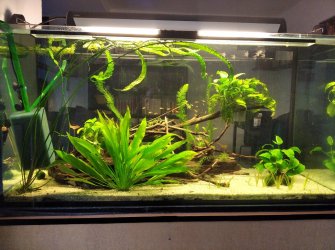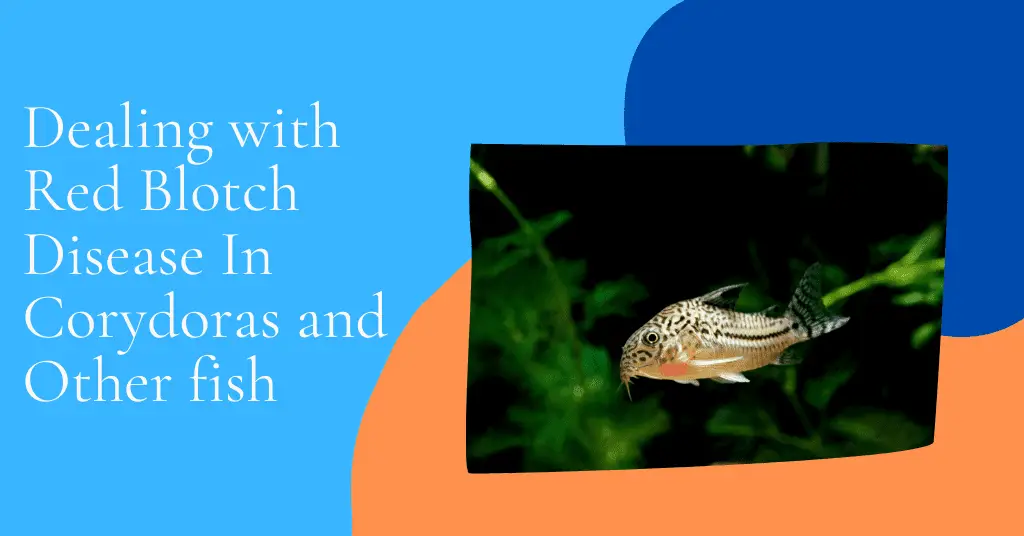Beastije
Fish Addict
So, I am disappointed in myself. After years of fishkeeping and sort of understanding the basics, I must have made some rookie mistake that led to a chain event that I am not sure the tank will survive.
Let me start when I think it begun -
10.3 I noticed one of my 15 cory cats had fungus in both eyes and missing barbels, other had missing barbels along with half its jaw or so. I took the one with missing jaw out, left the one with fungus or eye infection in the tank. Few days later the isolated one died despite medical treatment.
15.3 I noticed one of my male ember tetras, one of 40 pieces in the 360l tank, was thinner and bent in the stomach area. I took him out, put him in the quarantine tank, and after week of antifungal/antiparasitical medicine, returned him to the main tank good as new.
3.4 I saw the cory with the fungal eye and missing barbels at feeding time and decided to treat the whole tank with the same antifungal/antiparasitical medicine, in slightly lower doses, after water change, 3 day treatment. (obviously a mistake in hindsight)
7.4 one of fanning shrimp died, I assume as a direct result of the "safe for shrimp" medicine and 80% of hornwort shed its needles causing a large mess. I did a 50% water change, removed the plant as a whole, added limnobium to replace some of the plant matter and took out few stones and one large piece of wood.
Since then I did a bit more water changes than usual including a gravel clean, I used to do 30% every week, now I upped it to 30% every 5 days or so. I continued to feed the fish, the snails and so. I even tried adding more plants, though they didnt make it cause they were eaten by the snails.
This week I noticed the remaining two fan shrimp were forranging more on the substrate and filter intake sponge, so I fed a wee bit more to make sure they were fed, and included targeted squirts of crushed spirulina flakes in their direction. I fed in this week a piece of zucchini that stayed for 24 hours (which is normal, I keep carrots and bell peppers until they are eaten up to 48 hours, always a small piece and I do have 5 large snails) and a part of a leaf of a wild garlic, since its season started and other fish keepers here feed it too. It was eaten within few hours.
I obviously overfed or something, because today:
the corydoras with the bling eyes and still mostly missing barbels (it is fully blind, it doesnt scatter when I approach, but it is feeding normally) made an appearance, but there was a second corydoras, same condition, but rapid breathing, bloated belly and a smallish red dot on the underside. It is very passive but not overly so, swimming with others, retreating when startled. I also noticed one of the male ember tetras is again a bit skinny with sunken belly
I did a 30% water change and thoroughly washed the filter intake sponge and increased the main filter flow a bit. I will not feed until sunday and I added two 40cm pieces of healthy hornwort that I kept in other tank to grow to help leach the nutrients out of the water.
I dont expect the cory to survive this, obviously bad water quality or bacterial infection which indicates something in the tank is wrong.
As fate would have it, I have to leave tomorrow and get back on sunday, so if the fish dies, I will not be able to get it out of the tank.
Now I am considering what is the next step. Obviously the gravel should be cleaned again, I should also remove the small stones in the sand, on the off chance that the stones are causing the barbel injuries to the 3 corydoras out of the 15 I had in this tank for the past 6 months. I should also do a filter cleanup and ideally lift all the wood in the tank and clean under it. All of this cant be done at once or I will lose all the bacteria. The stone removal will also mean sifting through the sand and increasing detritus flow, which will lead to worse water quality.
Obviously something needs to be done in this tank I just dont know what and in what order to cause the least amount of damage. I cannot move the fish elsewhere, though in theory I have two smaller tanks that are empty and dirty so I could set them up, but with my workload maybe next weekend, maybe later. I could also perhaps take all the fish out, do the cleaning, follow up with mild filter clean, put 80% of new water in, give it 8 hours and return the fish. Though I am not sure how far to take it to not do worse with the cycle.
I did an No2 test after the water change, because I didnt consider doing it before, and it is zero.
Let me start when I think it begun -
10.3 I noticed one of my 15 cory cats had fungus in both eyes and missing barbels, other had missing barbels along with half its jaw or so. I took the one with missing jaw out, left the one with fungus or eye infection in the tank. Few days later the isolated one died despite medical treatment.
15.3 I noticed one of my male ember tetras, one of 40 pieces in the 360l tank, was thinner and bent in the stomach area. I took him out, put him in the quarantine tank, and after week of antifungal/antiparasitical medicine, returned him to the main tank good as new.
3.4 I saw the cory with the fungal eye and missing barbels at feeding time and decided to treat the whole tank with the same antifungal/antiparasitical medicine, in slightly lower doses, after water change, 3 day treatment. (obviously a mistake in hindsight)
7.4 one of fanning shrimp died, I assume as a direct result of the "safe for shrimp" medicine and 80% of hornwort shed its needles causing a large mess. I did a 50% water change, removed the plant as a whole, added limnobium to replace some of the plant matter and took out few stones and one large piece of wood.
Since then I did a bit more water changes than usual including a gravel clean, I used to do 30% every week, now I upped it to 30% every 5 days or so. I continued to feed the fish, the snails and so. I even tried adding more plants, though they didnt make it cause they were eaten by the snails.
This week I noticed the remaining two fan shrimp were forranging more on the substrate and filter intake sponge, so I fed a wee bit more to make sure they were fed, and included targeted squirts of crushed spirulina flakes in their direction. I fed in this week a piece of zucchini that stayed for 24 hours (which is normal, I keep carrots and bell peppers until they are eaten up to 48 hours, always a small piece and I do have 5 large snails) and a part of a leaf of a wild garlic, since its season started and other fish keepers here feed it too. It was eaten within few hours.
I obviously overfed or something, because today:
the corydoras with the bling eyes and still mostly missing barbels (it is fully blind, it doesnt scatter when I approach, but it is feeding normally) made an appearance, but there was a second corydoras, same condition, but rapid breathing, bloated belly and a smallish red dot on the underside. It is very passive but not overly so, swimming with others, retreating when startled. I also noticed one of the male ember tetras is again a bit skinny with sunken belly
I did a 30% water change and thoroughly washed the filter intake sponge and increased the main filter flow a bit. I will not feed until sunday and I added two 40cm pieces of healthy hornwort that I kept in other tank to grow to help leach the nutrients out of the water.
I dont expect the cory to survive this, obviously bad water quality or bacterial infection which indicates something in the tank is wrong.
As fate would have it, I have to leave tomorrow and get back on sunday, so if the fish dies, I will not be able to get it out of the tank.
Now I am considering what is the next step. Obviously the gravel should be cleaned again, I should also remove the small stones in the sand, on the off chance that the stones are causing the barbel injuries to the 3 corydoras out of the 15 I had in this tank for the past 6 months. I should also do a filter cleanup and ideally lift all the wood in the tank and clean under it. All of this cant be done at once or I will lose all the bacteria. The stone removal will also mean sifting through the sand and increasing detritus flow, which will lead to worse water quality.
Obviously something needs to be done in this tank I just dont know what and in what order to cause the least amount of damage. I cannot move the fish elsewhere, though in theory I have two smaller tanks that are empty and dirty so I could set them up, but with my workload maybe next weekend, maybe later. I could also perhaps take all the fish out, do the cleaning, follow up with mild filter clean, put 80% of new water in, give it 8 hours and return the fish. Though I am not sure how far to take it to not do worse with the cycle.
I did an No2 test after the water change, because I didnt consider doing it before, and it is zero.








